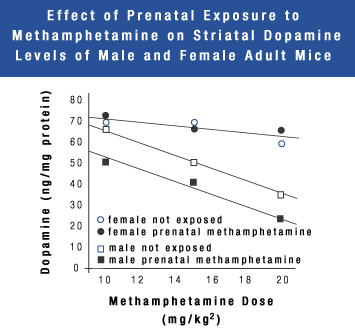 |

By Kimberly R. Martin, NIDA NOTES Contributing Writer
A NIDA-funded study has shown that exposure to methamphetamine before birth results in more severe neurotoxic effects in male mice given the drug as adults than in females. These findings raise concerns regarding the long-term health consequences of methamphetamine use, particularly for men who were exposed to the drug in utero.

Adult mice were given two doses of methamphetamine 2 hours apart. One week after the drug injections, their brains were analyzed for dopamine. Males that had been prenatally exposed to methamphetamine had a greater reduction in striatal dopamine levels compared with females and unexposed males. |
|
Methamphetamine is known to be a neurotoxic agent that damages the endings of brain cells containing dopamine, a brain chemical that regulates movement, emotion, motivation, and feelings of pleasure. Previous research in animals has indicated that methamphetamine causes damage to cells in the striatal and cortical regions of the brain. In humans, these regions are associated with memory, cognitive function, and movement.
"Many young people using club drugs such as methamphetamine are cavalier about its dangers. They mistakenly believe that they can use these drugs with no consequences," says Dr. Jerry Frankenheim of NIDA's Division of Neuroscience and Behavioral Research. "Although this study was conducted in mice, these findings suggest that the children, especially sons, of pregnant women who abuse methamphetamine may suffer the consequences of their mothers' actions later in life."
To investigate the effects of methamphetamine exposure in utero, Drs. Alfred Heller and Lisa Won at the University of Chicago injected pregnant female mice with neurotoxic doses of methamphetamine or saline twice daily from gestational days 7 through 18. At 11 weeks of age (equivalent to young adulthood), the offspring received two injections of either saline or methamphetamine in a range of doses. Rectal temperatures were measured hourly from just before the first injection to at least 4 hours after the second injection. Seven days later, the mouse brains were analyzed for dopamine and its metabolites in the striatum, ventral and dorsal brainstem, cortex, and cerebellum.
Fetal exposure to methamphetamine alone did not affect dopamine or its metabolite levels, but after methamphetamine exposure of the adults, considerable differences were observed between the adult male and female offspring. Adult males had lower levels of dopamine and its metabolites in the striatum and cortex than did females. In addition, the prenatally methamphetamine-exposed males had greater reductions than any other group. A 20 mg/kg2 dose of the drug in an adult produced a 70-percent reduction of striatal dopamine in prenatally methamphetamine-exposed males, compared to a 55-percent reduction in unexposed males. Females showed a 14- to 25-percent reduction in striatal dopamine. In the brainstem, only the prenatally methamphetamine-exposed males suffered a reduction of dopamine from exposure to the drug as an adult. Effects of methamphetamine on cortical dopamine were not enhanced by prenatal exposure to the drug.
"The increased dopamine losses observed in prenatally exposed males in response to adult exposure to the drug occurred in the regions of the brain that are affected by neurological disorders such as Parkinson's disease," says Dr. Heller. "If similar neurological effects are occurring in humans, males whose mothers used methamphetamine during pregnancy may be at a greater risk for developing these ailments."
Previous research has indicated that the neurotoxic effects of methamphetamine are associated, in part, with its ability to raise body temperature. Hyperthermia, however, did not account for the increased susceptibility of prenatally methamphetamine-exposed males compared to other males. Adult males exhibited the same rise in body temperature whether or not they had been exposed to methamphetamine in utero.
The hyperthermic effects of methamphetamine were a contributing factor to the differences in neurotoxicity observed between males and females. Adult females did not exhibit a change in body temperature in response to methamphetamine exposure, while adult males did exhibit a rise in body temperature.
"The finding that the female mice in this study did not experience the same degree of neurotoxicity or hyperthermic effects when given methamphetamine as adults does not mean that female offspring are safe from harm," cautioned Dr. Heller. "Other research indicates that the age of adult exposure to methamphetamine may play a role in susceptibility to the drug's effects. This study was conducted in animals that were equivalent to young adults. The same findings may not hold true for younger or more mature female mice."
Source
- Heller, A.; Bubula, N.; Lew, R.; Heller, B.; and Won, L. Gender-dependent enhanced adult neurotoxic response to methamphetamine following fetal exposure to the drug. Journal of Pharmacology and Experimental Therapeutics 298:769-779, 2001. [Abstract]
Volume 17, Number 2 (May 2002)
|
 |
|